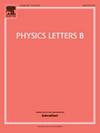计算复合运算符相关函数的有用技巧
IF 4.3
2区 物理与天体物理
Q1 ASTRONOMY & ASTROPHYSICS
引用次数: 0
摘要
一般来说,在规范场理论中,物理观测是由规范不变的复合算符来表示的,例如电磁电流。正如我们最近在U(1)和SU(2)希格斯模型[1],[2],[3]的背景下所证明的那样,规范不变算子的相关函数表现出非常好的性质。除了众所周知的规范独立性之外,它们不呈现非物理切割,并且它们的Källén-Lehmann表示是肯定的,至少是摄动的。尽管有这些有趣的特性,但它们的使用并不像基本字段那么多,主要是因为它们的计算和重整化涉及到额外的复杂性。在本文中,我们给出了一个有用的技巧来计算复合运算符相关函数的循环修正。这个技巧包括引入一个没有动态的附加字段,与感兴趣的复合算子耦合。通过这种方法,我们可以使用传统的算法来计算初等场的相关函数。本文章由计算机程序翻译,如有差异,请以英文原文为准。
Useful trick to compute correlation functions of composite operators
In general, in gauge field theories, physical observables are represented by gauge-invariant composite operators, such as the electromagnetic current. As we recently demonstrated in the context of the and Higgs models [1], [2], [3], correlation functions of gauge-invariant operators exhibit very nice properties. Besides the well-known gauge independence, they do not present unphysical cuts, and their Källén-Lehmann representations are positive, at least perturbatively. Despite all these interesting features, they are not employed as much as elementary fields, mainly due to the additional complexities involved in their computation and renormalization. In this article, we present a useful trick to compute loop corrections to correlation functions of composite operators. This trick consists of introducing an additional field with no dynamics, coupled to the composite operator of interest. By using this approach, we can employ the traditional algorithms used to compute correlation functions of elementary fields.
求助全文
通过发布文献求助,成功后即可免费获取论文全文。
去求助
来源期刊

Physics Letters B
物理-物理:综合
CiteScore
9.10
自引率
6.80%
发文量
647
审稿时长
3 months
期刊介绍:
Physics Letters B ensures the rapid publication of important new results in particle physics, nuclear physics and cosmology. Specialized editors are responsible for contributions in experimental nuclear physics, theoretical nuclear physics, experimental high-energy physics, theoretical high-energy physics, and astrophysics.
 求助内容:
求助内容: 应助结果提醒方式:
应助结果提醒方式:


